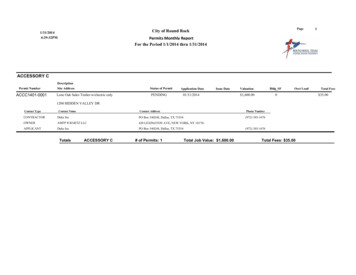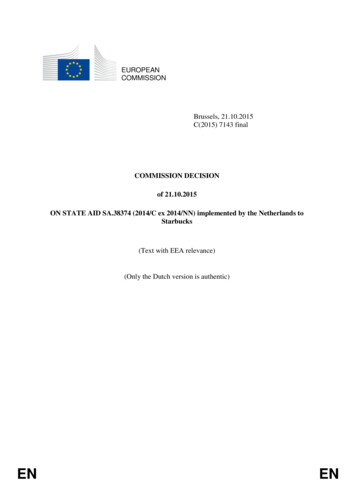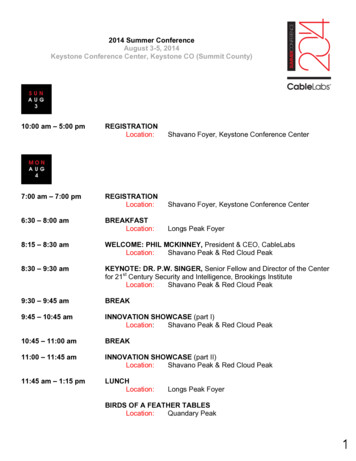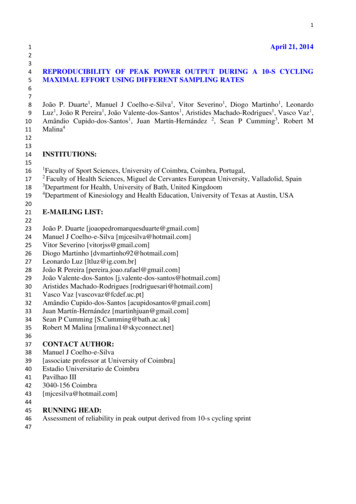
Transcription
303132333435363738394041424344454647April 21, 2014REPRODUCIBILITY OF PEAK POWER OUTPUT DURING A 10-S CYCLINGMAXIMAL EFFORT USING DIFFERENT SAMPLING RATESJoão P. Duarte1, Manuel J Coelho-e-Silva1, Vitor Severino1, Diogo Martinho1, LeonardoLuz1, João R Pereira1, João Valente-dos-Santos1, Aristides Machado-Rodrigues1, Vasco Vaz1,Amândio Cupido-dos-Santos1, Juan Martín-Hernández 2, Sean P Cumming3, Robert MMalina4INSTITUTIONS:1Faculty of Sport Sciences, University of Coimbra, Coimbra, Portugal,Faculty of Health Sciences, Miguel de Cervantes European University, Valladolid, Spain3Department for Health, University of Bath, United Kingdoom4Department of Kinesiology and Health Education, University of Texas at Austin, USA2E-MAILING LIST:João P. Duarte [joaopedromarquesduarte@gmail.com]Manuel J Coelho-e-Silva [mjcesilva@hotmail.com]Vitor Severino [vitorjss@gmail.com]Diogo Martinho [dvmartinho92@hotmail.com]Leonardo Luz [ltluz@ig.com.br]João R Pereira [pereira.joao.rafael@gmail.com]João Valente-dos-Santos [j.valente-dos-santos@hotmail.com]Aristides Machado-Rodrigues [rodriguesari@hotmail.com]Vasco Vaz [vascovaz@fcdef.uc.pt]Amândio Cupido-dos-Santos [acupidosantos@gmail.com]Juan Martín-Hernández [martinhjuan@gmail.com]Sean P Cumming [S.Cumming@bath.ac.uk]Robert M Malina [rmalina1@skyconnect.net]CONTACT AUTHOR:Manuel J Coelho-e-Silva[associate professor at University of Coimbra]Estadio Universitario de CoimbraPavilhao III3040-156 Coimbra[mjcesilva@hotmail.com]RUNNING HEAD:Assessment of reliability in peak output derived from 10-s cycling sprint
ABSTRACT:The study was aimed to investigate the reproducibility of performance parameters obtainedfrom 10-s sprints against different braking forces in young adult athletes. The sample (n 48)included male athletes aged 18.9-29.9 years (175.5 6.9 cm, 76.2 10.1 kg). The 10-smaximal exercise was performed in a cycle-ergometer against a random braking force (4% to11% of body mass). Intra-individual variation was examined from repeated tests within oneweek. Descriptive statistics were computed and differences between sessions tested usingpaired-t test. The coefficient of correlation between repeated measures, technical error ofmeasurement (TEM), coefficient of variation and ICC were calculated. Agreement betweentrials was examined using the Bland-Altman procedure. Mean values of peak power wererelatively stable when obtained from sampling rates of 50 Hz and ranged between 1068 wattand 1082 watt (t(47) 1.149, p 0.256, ES-r 0.165) or while corresponding to the best secondfrom the 10-s row data (t(47) 0.742, p 0.462, ES-r 0.107). Correlations between repeatedmeasures were high ( 0.907, 95%CI: 0.839 to 0.947) and TEM about 59.3 watt(%CV 5.52%; ICC 0.951, 95%CI: 0.912 to 0.972). The present study suggests thatreproducibility of peak power in male adult athletes tended to be acceptable.KEY WORDS:Anaerobic powertechnical error of measurementreliabilityintra-class correlationBland-Altman plotshort-term maximal intensity effortcycle-ergometer
312INTRODUCTION34Maximal mechanical power generated by skeletal muscle is usually estimated with5popularized vertical jump (31) that has the dimension of work not power. Although, several6formulae have been proposed to add velocity to the body mass and vertical height components7(15), the validity is questionable (2). Height jump is a function of the product of force and8time, not the product of force and velocity. A 30-s friction-braked cycle ergometer protocol9(Wingate test, WAnT) was introduced in 1971 (8) and is probably the most used cycle10ergometer protocol. It involves pedalling for 30 seconds against a constant braking force.11The original research using the WAnT (8) adopted the same braking force for all participants12(adolescents aged 12-17 years), but the subsequent versions of the test have related the13braking force to body mass (3). Standardized braking force of 0.74 N.kg-1 is commonly used14in children and adolescents (1, 14).1516Power output is conventionally calculated from the formula that considers the product17of angular velocity of the flywheel (in rad.s-1) and the resistive torque in N.m (given by the18product of the braking force and the radius of the flywheel). This method does not take into19account amount of work to overcome the inertia of the flywheel and the internal resistance20and results obtained from different ergometers should be interpreted with caution. Apart of21this, maximal power or peak power (PP) corresponds to optimal values of force (Fopt) and22velocity (Vopt) and the relationship largely depends on the types of muscle fibers (7, 27). The23force-velocity test (FVT) overcomes the methodological constraints experienced24WAnT regarding braking force related to body mass. It assumes a quasi-linear relation25between braking force and angular velocity, and a parabolic function between braking force26and power that is evident between 50 and 150 rev.min-1 (33, 34).by the2728Peak power outputs in WAnT and FVT is generally obtained over 1-s to 5-s epochs.29With the relative ease and popularity of computer driven data collection systems, estimates of30peak power over several time periods (1-, 3- or 5-seconds) are possible and facilitate31comparisons among data following different procedures. In the initial description of the test32(3), peak power output corresponded to the highest 5-s mean power. Few authors still adopt33the 5-s interval to obtain peak power (6). The influence of age, sex, body size, skinfold34thickness, thigh volume and isokinetic strength on peak power, for example, was estimated
41from the WAnT using a measure of peak power output over 1-s (9). At present, pedaling rate2can be measured at a high sampling frequency, while peak power can be measured more3accurately over shorter intervals. More recently, accurate assessments of power during a4WAnT was examined using a sampling frequency of 50 Hz (16). Peak output appeared5dependent on sampling rate (0.5 or 1 s) and it was suggested that a better to measure velocity6would be the average of a revolution rather than the average over a given time interval (11).78This study investigates the reproducibility of performance parameters on a 10-s9maximal sprint against different braking forces in male adult athletes. It also considers the10reproducibility of peak power provided by the cycle ergometer at a precision of 50 Hz and the11score sampled at 1 Hz from the 10-s interval, and the reproducibility of time at maximal12power and at maximal velocity.1314MATERIALS AND METHODS1516Peak output was measured on a 10-s cycle-ergometer sprint in male athletes aged 18.9-29.017years. The athletes were participants in several sports (judo, soccer, badminton, volleyball,18track and field, swimming, aquatic polo, tennis, surf and karate).19assessments were made within a period of one week.20informed consent was obtained in compliance with the Declaration of Helsinki (17).Forty-eight repeatedParticipation was voluntary and2122Participants were instructed not to eat for at least 3-h and not to drink coffee or23beverages containing caffeine for at least 8-h before each testing session. No participant was24suffering from musculoskeletal injury of the lower extremity at the time of testing or injury in25the preceding 6 months that limited activity for more than 48 hours. Anthropometry was done26by a single experienced observer according to standardized procedures (20). Stature was27measured with a portable stadiometer (Harpenden model 98.603, Holtain Ltd, Crosswell, UK)28to the nearest 0.1 cm. Body mass was measured with a portable balance (Seca model 770,29Hanover, MD, USA) to the nearest 0.1 kg. Intra-observer technical errors of measurement30were 0.5 cm for stature, 0.8 kg for body mass. These errors were within the range reported for31in variety of studies (23).3233After measurement of stature and body mass, all participants completed a standardized34warm-up of 4-min pedaling with minimal resistance (basket supported) at 60 rev min-1
51interspersed with three “all-out” sprints of 2-s to 3-s followed by static stretches of the2quadriceps and hamstring muscles.3Sweden) with the capacity for a sampling frequency of 50 Hz was used; the data were4transferred directly to a computer. Subsequent analyses were performed with ATS software5recommended for the ergometer by the manufacturer. Calibration was also done before each6test session according to recommendations of the manufacturer.A Monark 894 Peak Bike (Monark AB, Varberg,78The experimental protocol test involved a maximal exercise bout against randomly9selected braking forces (range 4%-11% of body mass). The test began with a rolling start10(weight basket supported pedaling at 60 rev.min–1); on the command “ready, go!”, the subject11began maximal effort pedaling with the braking force simultaneously applied. Strong verbal12encouragement was given throughout the exercise bout. Two peak power outputs were13considered for subsequent analyses:14sampled at 1 HZ, and PP-50Hz obtained using a sampling rate of 50 Hz.15sampling rate permitted the collection of time at maximal power and time at maximal16velocity.PP-1Hz corresponded to the best score with dataThe highest1718Descriptive statistics for age, stature, body mass and replicate sprint measurements were19computed for the total sample. Means and standard deviations of PP-1Hz, PP-50Hz, time ad20peak power and time at maximal velocity were calculated for each time moment. Differences21between the replicate tests were evaluated with paired-t test analysis. Effect size was22estimated using the square root of the ratio of the t-value squared and the sum of the t-value23squared and degrees of freedom (28). Coefficients of correlation between repeated measures,24technical errors of measurement, coefficients of variation (TEM divided by the mean of two25trials) and ICC were calculated. Levels of agreement between trials were also examined26using the Bland-Altman procedure (5). Pearson correlations between the means and27differences of two trials for peak power output (PP-1Hz, PP-50Hz) and stature and body mass28were also calculated. Coefficients were interpreted as recommended (18): trivial (r 0.1),29small (0.1 r 0.3) moderate (0.3 r 0.5), large (0.5 r 0.7), very large (0.7 r 0.9)30and nearly perfect (r 0.9) and perfect (r 1). Statistical significance was set at p 0.05 and31all analyses were performed using the Statistical Package for the Social Sciences version 17.032(SPSS, Chicago, IL).3334RESULTS
612Descriptive statistics for chronological age, anthropometry, braking force and peak power3outputs are given in Table 1. Mean values for the two measures of peak power (PP-1Hz, PP-450Hz) slightly decreased from the initial to the second sessions: 14 and 10 watt respectively5for PP-1Hz and PP-50Hz. However, as shown in Table 2, the mean differences between6sessions 1 and 2 were not significant.78[Table 1 about here]9[Table 2 about here]1011Bivariate correlations between repeated measures of peak power output were high and12significant: PP-1Hz ( 0.893) and PP-50Hz ( 0.907).13(TEM) are summarized in Table 3 for PP-50Hz (CV 5.52%) and for PP-1Hz (CV 6.10%).14Estimated coefficients of reliability (25) were 0.905 for PP50Hz and 0.891 for PP-1Hz.15Corresponding ICC were 0.951 for PP-50Hz and 0.941 for PP-1Hz.Technical errors of measurement1617[Table 3 about here]1819Correlations of peak power and body size are summarized in Table 4. The two peak20power measures were moderately correlated with stature, but poorly correlated with body21mass. The differences between repeated measures of peak power were poorly correlated with22body size given by stature and body mass. The Bland-Altman plots (Figures 1 and 2)23suggested that the magnitude of the differences between repeated assessments were within the24range of normal variation for the sample.2526[Table 4 about here]27[Figure 1 about here]28[Figure 2 about here]2930DISCUSSION3132Peak power outputs did not significantly differ between repeated trials (Table 2). The results33contrast those from a study of repeated assessment of peak cycling power in physical34education students of both sexes under four applied braking forces, 2.5%, 5.0%, 7.5% and
7110.0% of body mass (10). In the French study, performances improved substantially between2sessions from 1025 219 watt to 1069 243 watt. The study, however, did not include a3habituation session prior to the protocol, which leaded the authors to recommend inclusion of4a previous session for habituation.56Few studies have examined intensity-associated variation in the reliability of peak7power output generated in a single “all-out” 10-s episode.8estimated optimal peak power derived from the parabolic relationship between breaking force9and peak power. A quasi-linear relation between braking force and angular velocity, and a10parabolic function between braking force and power were noted between 50 and 150 rev.min-111(33, 34). The results implied a need to evaluate the assumption of the FVT above these limits.12It was suggested that at peak velocity (usually 200 rpm) of an all-out test against the inertia13of the flywheel, peak torque would occur at pedal angles between 140 and 150 degrees, i.e.,14before the end of the downward pedal motion. This is substantially different from peak15torque during a single revolution observed around 90 degrees when pedal rate is low to16medium (26). Of potential relevance, it has been suggested that most of the power in the17downstroke during maximal sprint cycling is produced at the hip and not at the knee as in18submaximal cycling (13, 24).The studies have examined1920The FVT protocol assumes a quasi-linear relation between braking force and angular21velocity, and a parabolic function between braking force and power that is evident between 5022and 150 rev.min-1 (33, 34). The protocol is increasingly used (4, 12, 19, 32) and provides a23promising model for research. However, reports on its reliability are still limited. The24number of sprints, rest interval between episodes, randomization of braking forces,25standardization of the warm-up protocol and sport background of participants are potential26sources of variation that need consideration. The current study examined the observed peak27obtained in a single 10-s “all-out” episode against braking forces randomly selected between284.1% and 11.4% of body mass (Table 1). The breaking force for each athlete was exactly the29same in the two sessions, but was not constant among subjects. In a related study using “all-30out” sprints against four braking forces until maximal speed (10). Available technology31permits that a particular assessment is immediately stopped after the detection of a decline for32three consecutive revolutions (29) to reduce fatigue by subtracting each sprint by about 2-533seconds, which corresponded to a total of 8-20 seconds in the sum of four “all-out” episodes.34
81The expression of peak output is quite variable in the literature, which makes it difficult2to compare studies. Peak power output is expressed for a large range of sampling rates (0.23Hz to 50 Hz) and also as a mean value over 1-s, 3-s or 5-s periods which result in smoothed4curves (30). Among 26 physically active non-athlete young males, for example, peak power5was substantially attenuated when sampling rates were 0.2 Hz compared to high sampling6rates ( 5 Hz). Time to attain peak power output was markedly delayed, 54%, from 5Hz to7low sampling rates of 0.2 Hz. According to the sampling theorem, if H is the highest8frequency of any continuous function, then the sampling rate must be at least twice H to allow9for perfect signal reconstruction and to avoid distortion known as aliasing (21, 22). Mean10peak pedaling rate in the present study was 142 17 rotations.min-1 (range: 110-18811rotations.min-1) assuming a sampling rate of 2.5-3.0 Hz. This corresponds to a12recommendation for a sampling rate at least 5.0-6.0 Hz.1314In the present study, scores obtained at 50 HZ did not substantially differ from scores15sampled at 1 second (PP-1Hz) over a period of 10-s (17 watt in time moment 1, 13 watt in16time-moment 2).17moments (14 watt for PP-50HZ, 10 watt for PP-1Hz). The mean difference between sessions18was 44 watt in the study of physical education students (10). Note, however, this study used a19calibrated friction-braked ergometer (Ergomeca, Sorem, Toulon, France) without information20on sampling frequency.The differences were similar to the mean differences between time2122In summary, the reproducibility of peak power in adult male athletes in several sports is23acceptable when derived from an ergometer that provides sampling rates of 50 Hz.24Differences between repeated sessions (error) were not significantly correlated with body size25or braking force expressed as a percentage of body mass. This is highly relevant since error26associated with braking force (Fb) would affect the parabolic relationship between Fb and27peak power output. Moreover, technical errors of measurement, coefficients of reliability and28Bland-Altman 95 % limits of agreement indicated that force-velocity measures were29reasonably reliable in trained adults.30appropriate session of habituation are recommended, specially among untrained participants,31and results from studies that adopted distinct sampling rates should be interpreted with care.32it is believed that the potential impact in peak power output due to the precision of the33sampling rate may be more apparent in protocols adopting 0.2 Hz (power output sampled over34a 5-s period).Standardization of test procedures, including an
912ACKNOWLEDGMENTS34This research was partially supported by Fundação para a Ciência e a Tecnologia5[SFRH/BD/64648/2009, SFRH/BD/69447/2010, SFRH/BD/72111/2010, CAPES BEX61617/13-3]. To the memory of Filipe Simoes (PhD-candidate, SFRH/BD/78603/2011) who7died in February 2013. The authors have no potential conflicts of interest. The research was8not funded by any organization. The authors also have no professional relationships with any9for-profit organization that might potentially benefit from the study.1011REFERENCES121.1314Armstrong N, Welsman J, Kirby BJ: Performance on the Wingate anaerobic test andmaturation. Pediatr Exerc Sci. 9, 253-261 (1997)2.Armstrong N, Welsman J, Williams C (2008): Maximal intensity exercise. In:15Paediatric Exercise Science and Medicine, eds Armstrong N, van Mechelen, Oxford16University Press, Oxford, pp. 55–66173.Bar-Or O (1993): Noncardiopulmonary Pediatric Exercise Tests. In: Pediatric18Laboratory Exercise Testing, eds Rowland T, Human Kinetics, Champaign, pp. 165–19185204.Bedu M, Fellmann N, Spielvogel H, Falgairette G, Van Praagh E, Coudert J: Force-21velocity and 30-s Wingate tests in boys at high and low altitudes. J Appl Physiol. 70,221031-1037 (1991)235.2425Bland J, Altman D: Statistical methods for assessing agreement between two methodsof clinical measurement. Lancet. 1, 307-310 (1986)6.Carvalho H, Coelho-e-Silva M, Goncalves C, Philippaerts R, Castagna C, Malina R:26Age-related variation of anaerobic power after controlling for size and maturation in27adolescent basketball players. Ann Hum Biol. 38, 721-727 (2011)287.2930Close R: Dynamic properties of mammalian skeletal muscles. Physiol Rev. 52, 129-197(1972)8.Cumming G (1973): Correlation of athletic performance and aerobic power in 12-to 17-31year-old children with bone age, calf muscle, total body potassium, heart volume and32two indices of fatigue. In: Pediatric Work Physiology, eds Bar-Or O, Wingate Institute,33Netanya, pp. 109-34.
1019.23short-term power output in 10- to 12-year-olds. J Sports Sci. 19, 141-148 (2001)10.45Dore E:, Duche P, Rouffet D, Ratel S, Bedu M, Van Praagh E: Measurement error inshort-term power testing in young people
4 1 from the WAnT using a measure of peak power output over 1-s (9). At present, pedaling rate 2 can be measured at a high sampling frequency, while peak power can be measured more 3 accurately over shorter intervals. More recently, accurate assessments of power during a 4 WAnT was examined using a sampling frequency of 50 Hz (16). Peak output appeared
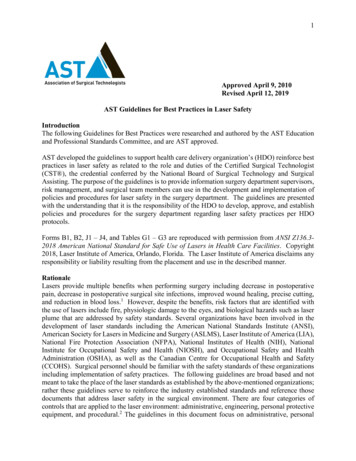

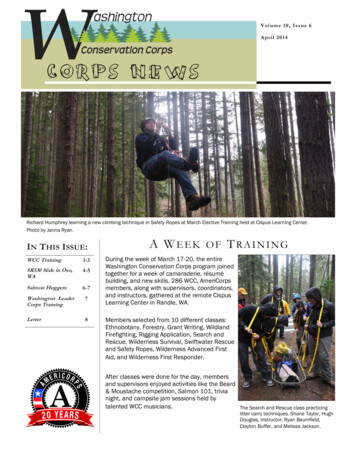

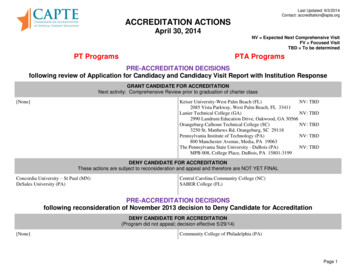

![Sample PRINCIPAL Goal TEMPLATE-April 2014[3]](/img/13/ppgessample-principal-goal-template-april-20143.jpg)


